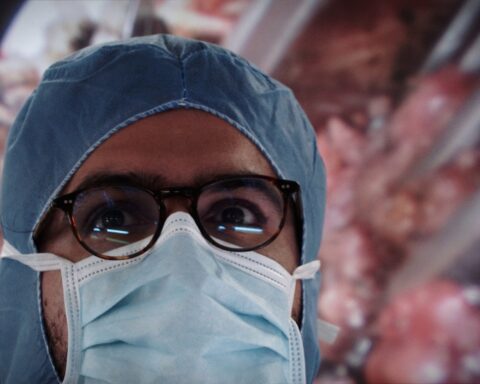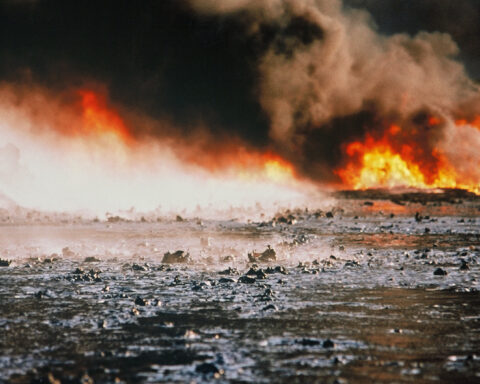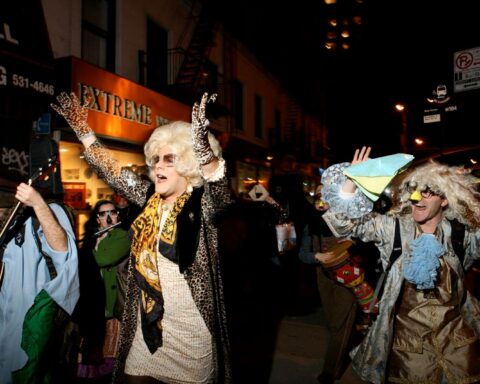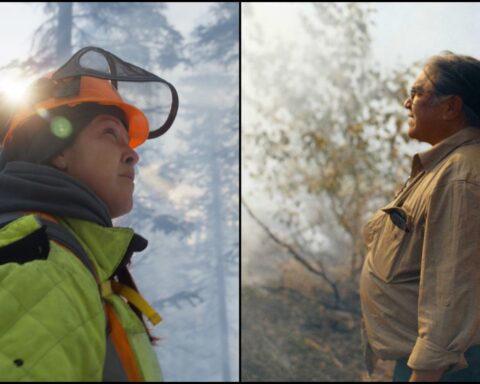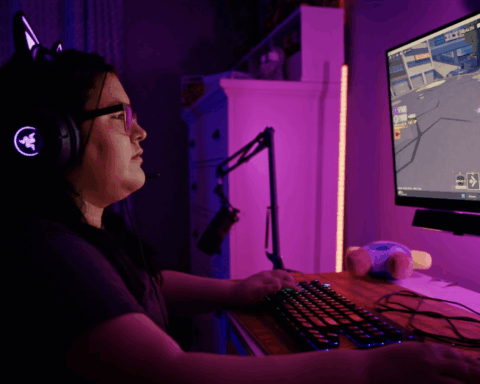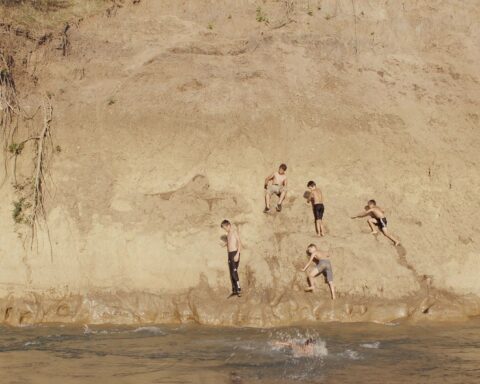IN THE PAST 25 YEARS, there have been two movies released with the title Leviathan: a totally ’80s underwater horror flick helmed by the venerable Greek schlock-meister George P. Cosmatos and a 2012 documentary co-directed by a couple of anthropologists from Harvard. And, wouldn’t you know it, the one by the Ivy Leaguers is scarier. A thick, bloody slab of post-verité shot on a fishing vessel off the coast of New Bedford, Mass., Lucien Castaing-Taylor and Véréna Paravel’s Hobbes-monikered monster swims powerfully against the current of commercial documentaries. Where most non-fiction productions attempt to make sense of the world, Leviathan revels in disorientation. Just as the filmmakers had to find their sea legs over the course of a stormy shoot, viewers are forced to adjust their expectations to the movie’s roiling rhythms.
Since its world premiere last summer at the Locarno Film Festival, Leviathan has trawled the festival circuit, snagging a few prestigious awards to go along with a string of sterling reviews. It’s easily the most successful film to date produced by Harvard’s Sensory Ethnography Lab (SEL), a new department overseen by Castaing-Taylor. The SEL’s stated mandate is to foster “creative work and research that is constitutively visual or acoustic—conducted through audiovisual media rather than purely verbal sign systems.” In other words, the SEL’s array of films, videos, field recordings and gallery installations—which will be featured this fall in a comprehensive retrospective hosted by RIDM (Rencontres internationales du documentaire de Montréal)—are largely unconcerned with language, whether in the form of interviews, voice-over narration or on-screen text. Leviathan’s full-on audiovisual assault, in which an array of GoPro cameras are wielded ingeniously to provide seemingly impossible first-person perspectives (it’s as if the equipment had been possessed by demons), captures only a few shouted words of communication between the crew members. It’s a movie without speech that leaves its audience speechless.
This silence extends to the filmmakers themselves. Castaing-Taylor—whose previous feature, Sweetgrass (2009, co-directed by Ilsa Barbash), documented the last in a series of annual sheep-herding treks through Montana’s Absaroka-Beartooth mountains—is famously reluctant to talk in detail about his practice. At a time when filmmakers of all kinds seem almost too eager to set the boundaries of how their work should be discussed, his reticence is almost refreshing. It should be noted that Castaing-Taylor was instrumental in organizing the interviews for this article, even if he politely declined to be interviewed himself.
At the same time, the SEL is an academic institution specializing in graduate-level instruction, and as the projects developed under its banner continue to garner international attention and acclaim, it’s only natural that journalists, critics, academics and audience members would be interested in gaining some insight into the theories and themes behind them. Those unconvinced by the SEL’s mission statement to work against the conventions of broadcast journalism and “art that [is] not deeply infused by the real”—a one-two punch implying that most non-fiction filmmaking is bogus—might want to hear a case for the defence.
”The SEL definitely grew out of anthropology, visual anthropology in particular,” explains Véréna Paravel, who emailed with POV on the eve of a trip to Japan. “We have become more and more concerned to explode the genre of ethnographic film, and visual anthropology— it is myopic, too mired in academia and anthropology alone. We have tried to open the SEL up more and more to art, without compromising our interest in ethnography.” There is a precedent for this hybridization of approaches between the poetic and the purely factual, and Paravel is the first to admit that the lab’s interests do not exist in a film-historical vacuum but rather extend back to the earliest days of the medium. “Many of the concerns of works coming out of the SEL go back to the beginnings of cinema, Lumière and Melies, to Flaherty and Grierson, to Mead and Bateson and Deren. They are not all new. I think that SEL films for the most part are in some ways in counterpoint to mainstream docs. They’re less discursive, less interpretive, more invested in aesthetic opaqueness and the interpretive agency of the viewer. But many filmmakers, whether part of the self-applied avant-garde or experimental traditions or not, also militate against the mainstream.”
There is indeed something militant about many of the SEL films, which truly earn the critical cliché of being “deceptively complex.” A film like Foreign Parts (2010), which Paravel co-directed with fellow SEL instructor J.P. Sniadecki, may appear at a glance to be relatively conventional: a verité exploration of a self-contained American enclave, in this case the scrap yards of Willets Point, New York. But despite its seemingly picaresque aimlessness, with the camera wandering between episodes featuring various local characters ranging from chop-shop workers to manic street preachers, Foreign Parts has a very pronounced point of view. Without ever explaining the situation via traditional techniques (narration, interviews or onscreen graphics), Sniadecki and Paravel suggest that Willets Point is a community on the precipice of mass gentrification.
Insofar as it strives to catalogue specific sights, sounds and experiences in a place that is considered to be an impediment to an institutionalized sort of progress, Foreign Parts is a political film. It turns its gaze on an environment forged not out of intention but systematized neglect, and the structuring absence is structure itself: more specifically, even a rudimentary sense of infrastructure. There’s little evidence that the city of New York cares much about Willets Point even in light of its unique status as a “destination” for citizens from other boroughs, or at least those looking to fix or augment their cars on the cheap. It’s not the least of the film’s ironies that the 39th Avenue neighbourhood is dominated by a structure located just beyond its purview—Citi Field, a potent symbol of 21st-century redevelopment (it replaced Shea Stadium as the home of the Mets) and also a pretty obvious signifier of economic disparity—a literally and figuratively concrete metaphor for a two-tiered social system.
Like Paravel, Sniadecki is a veteran of the SEL. After arriving at Harvard in 2006, he met Castaing-Taylor while the latter was “shopping” an introductory production course to new students. “For me, [the lab] was a godsend,” he says. “After going through the standardfare film and production classes in my undergraduate studies that encouraged more conventional forms of filmmaking, I finally found an infrastructure and a community to support and challenge and take seriously the creative output I was interested in pursuing.” Sniadecki’s other films for the SEL are more formally radical than Foreign Parts. The Yellow Bank (2010) is a study of the Shanghai skyline in the midst of a solar eclipse—a potent visual metaphor for a city shrouded in perpetual uncertainty—while the remarkable People’s Park (co-directed by Libbie Dina Cohn) snakes its way through a crowded public gathering in Sichuan in one single, unbroken shot: it’s verité by way of Aleksandr Sokurov, or maybe Brian De Palma. Among the many recent documentaries about contemporary Chinese society, Sniadecki’s films stand out not only for their patience and rigour but also their avoidance of obvious talking points. In lieu of trying to frame the “bigger picture” about a country whose complexities are nearly as myriad as its population, Sniadecki zeroes in on tiny, telling details that actually enlarge the scope of the work.
Sniadecki admits that there’s something rarified about the films he’s made for the SEL, and concurs with Paravel about the benefits of being trained to think about and produce non-fiction movies in a different way. He believes that the recent popularity of the SEL’s output on the festival circuit is not in spite of its conspicuous sense of difference, but because of it. “It seems to be the case that marginality or minority status grants a strength or power to a position or a movement,” he says. “It is the same for my Chinese peers and colleagues who produce independent documentaries on the margins of Mainland cinema and Chinese society itself. Their power and their politics gain strength and compel interest precisely because they form a counterdiscourse to the mainstream.”
Stephanie Spray, who was also one of the first graduate students at the SEL, confirms that there is a sense of solidarity at work but that claims of a “house style” are overstated. “It’s pretty intense,” she says over the phone from Cambridge. “I’ve found that I agree a lot with Lucien and Véréna aesthetically, and we tend to make similar observations. But the question of whether there’s a hallmark or a group style, or shared values…people produce all kinds of work here. The work that gets seen tends be of a certain kind, which leads people to believe that the Sensory Ethnography Lab is purely observational. But people have tried other things, with different kinds of cutting, or jump-cutting or playing with the image, but they haven’t been seen as much.”
Spray’s 2008 short Monsoon-Reflections is as calm and placid as Leviathan is fierce and ferocious, but it works similarly to create an intimate sense of proximity between the viewer and a very physical sort of labour. Its subjects are two female field hands in Lekhnath, Nepal, whose monsoon preparations play out as a sort of weary ritual, albeit one touched by beauty: an early close-up of a woman’s hands furiously rolling chili peppers has an uncanny quality. “The films that I’ve found the most interesting are the ones that give me time to look,” says Spray. “There’s always direction in how a film is shot and edited but I like when a shot develops on its own and gives me a sense of time and place. That’s something that I took away from the work I saw [in the lab].”
SPRAY’S NEW FEATURE, MANAKAMANA (co-directed by Pacho Velez), which was tapped for TIFF’s experimental Wavelengths programme, finds the filmmaker returning to Nepal; its serialized structure recalls the approach of James Benning. The film is comprised of 11 static shots taken inside the cab of a high-tech cable car that traverses a 1,300-metre mountain housing a religious temple; each sequence describes the journey up or down the mountain as experienced by the car’s human (or animal) cargo. “The whole film takes place in that space, so you never get to see the mountain as a whole,” explains Spray. “It’s limited to what you see through the window and what the people say.” The fixed-camera position ties into the idea that MANAKAMANA is more a piece of field recording than filmmaking, but Spray emphasizes that it’s a lot more complicated than simply flipping a switch and taking five. “A number of people have asked if we just left a camera rolling in there,” she says. “I don’t think that we would have achieved the same level of intimacy if we hadn’t been [present]. It almost feels like fiction, but it’s better than fiction because you couldn’t get actors to do this for you. You couldn’t get them to be this subtle. It’s the perfect conceit for studying people, for having an excuse to look at them as they look out at this landscape.”
Not all of the SEL’s works are visual studies. Ernst Karel, who is the lab’s manager as well as a lecturer, specializes in sound-based works. His course is called “sonic ethnography,” which he says is about analyzing sound recordings made in very specific contexts. His 2012 project “Materials Recovery Facility” is a streaming audio work comprised of recordings of a recycling plant in Boston, while 2011’s “Swiss Mountain Transport Systems” captures the various drones and tones of gondolas and chairlifts in Switzerland. “My dual background in anthropology and various aspects of sound and music production and postproduction struck [Lucien] as being interesting,” recalls Karel, who also works as a composer and a mastering engineer. “He’s always been attuned to the importance of sound in audiovisual work, and despite my lack of experience in video, he liked the idea of having someone in the lab who would think of sound issues first rather than, as is too often the habit in video work, last.”
Sound is everything in Leviathan: its collagist soundtrack is central to its skull-rattling impact. “I was never on the boat myself, but I got a sense of Lucien and Véréna’s impressions from experiencing roughcut screenings and walking past the door where they were editing,” say Karel, who is credited on the film as a “sound composer.” “Even before starting on the mix, [they] had combined several layers of sound, mostly from the GoPro cameras, so the sound was characterized by a very harsh digital edge from the extremely low-quality audio tech used in those cameras.” Leviathan’s stylized soundscape is remarkable for the way it both reinforces and heightens the feeling of realism. While the sound design is obviously more sophisticated than a mere field recording, the idea is to authentically represent the deafening aspect of shipping out under extreme conditions—which in this case means maxing out the soundtrack beyond the capabilities of some low-tech GoPro cameras.
Paravel says that there are a few misconceptions about Leviathan, namely that its cinematography was untouched by human hands. “One example of something I’ve seen repeated that is untrue is that we had an arsenal of cameras fixed to a trillion different places on the boat. This goes hand in hand with the fetishization of the new small digital technology, as if the filmmaker is neither here nor there. But we rarely had more than one camera rolling at one time, and every single shot in Leviathan — except for four of them — was attached to a body, ours or the fishermen. We’ve said this, somewhere, but whether anyone will take note or not, who knows. In any event, it’s not uninteresting to think about the reasons why critics might come away thinking that most of the shots were not filmed by a human.”
It will be interesting to see whether Leviathan will loom as large as its namesake over the documentary landscape (although it might be the hardest to imitate of any of the decade’s key non-fiction work). In the meantime, the SEL continues to grow and turn out films that hopefully will not be swallowed up by the behemoth in their midst but rather travel far and wide in its wake. “Lucien and I co-taught the main Sensory Ethnography class last year, and most of the [guests] that we invited were artists and filmmakers, not visual anthropologists,” says Paravel. “The hope is that the friction generated by bringing anthropology, art and cinema into juxtaposition with one another will continue to develop interesting work, in ways that we can’t predict— and certainly in ways we would not wish to forestall or control.”





